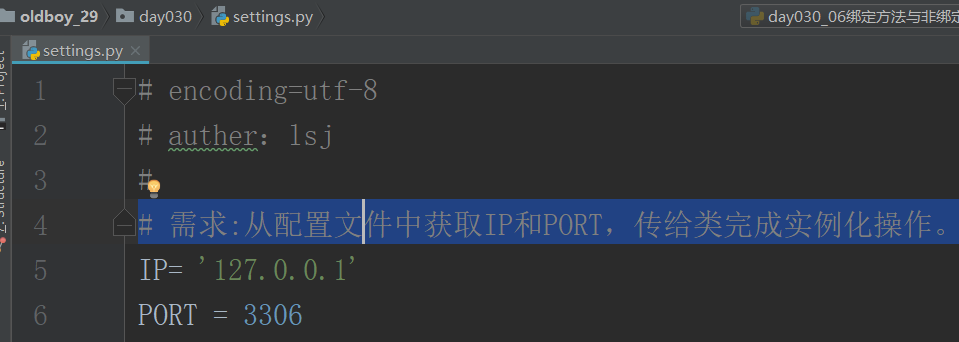Python的绑定方法与非绑定方法
绑定方法与非绑定方法
类中定义的函数分为两大类:绑定方法和非绑定方法。
一、绑定方法
# encoding=utf-8
# auther:lsj
# 绑定方法与非绑定方法
# classmethod
# 一、绑定方法:特殊之处在于将调用者本身当作第一个参数自动传入
# 1、绑定给对象的方法:调用者是对象,自动传入的是对象。
# 2、绑定给类的方法:调用者是类,自动传入的是类,使用classmethod。
class Mysql:
def __init__(self,ip,port): # 这里的self接受传入的对象
self.ip = ip
self.port = port
def func(self): # 此时的函数体接受的是对象,绑定的就应该是对象
print('%s:%s'%(self.ip,self.port))
# 实例化举例一
obj1 = Mysql('1.1.1.1',3306)
# 实例化举例二

# encoding=utf-8
# auther:lsj
#
# 需求:从配置文件中获取IP和PORT,传给类完成实例化操作。
IP= '127.0.0.1'
PORT = 3306
# 需求:从配置文件中获取IP和PORT,传给类完成实例化操作。
# import day030.setting
from day030 import settings
obj2 = Mysql(settings.IP,settings.PORT)
# 因为上面实例化举例二中太麻烦,所以实例化举例三
2、绑定给类的方法:调用者是类,自动传入的是类,使用@classmethod
from day030 import settings
class Mysql:
def __init__(self,ip,port): # 这里的self接受传入的对象
self.ip = ip
self.port = port
def func(self): # 此时的函数体接受的是对象,绑定的就应该是对象
print('%s:%s'%(self.ip,self.port))
# def from_conf():
# return Mysql(settings.IP,settings.PORT)
@classmethod # 绑定给类的方法,将下面的函数装饰成绑定给类的方法
def from_conf(cls):
print(cls)
return cls(settings.IP,settings.PORT)
# Mysql.from_conf() # 绑定到类的方法<class '__main__.Mysql'>
obj3 = Mysql.from_conf()
print(obj3.__dict__) # 调用类方法,自动将类MySQL当作第一个参数传给cls{'ip': '127.0.0.1', 'port': 3306}
总结:在类中正常定义的函数默认是绑定到对象的,而为某个函数加上装饰器@classmethod后,该函数就绑定到了类。
绑定到类的方法就是专门给类用的,但其实对象也可以调用,只不过自动传入的第一个参数仍然是类,也就是说这种调用是没有意义的,
并且容易引起混淆,这也是Python的对象系统与其他面向对象语言对象系统的区别之一,比如Smalltalk和Ruby中,绑定到类的方法与绑定到对象的方法是严格区分开的。
二、非绑定方法
# encoding=utf-8
# auther:lsj
# 类中的函数一个是绑定给对象用,一个是绑定给类用
# 非绑定方法-->静态方法
# 没有绑定给任何人:调用者可以是类,也可以是对象,没有自动传参的效果。
# 思考:有没有一种函数即不需要传递类也不需要传递对象,就是一个独立的功能
class Mysql:
def __init__(self,ip,port):
# self.nid =
self.ip = ip
self.port = port
@staticmethod # 将下述函数装饰成一个静态方法,非绑定方法
# 创建一个id号
def create_id(): # 此时的函数体代码既不依赖于类,也不依赖于对象import uuid
return uuid.uuid4()
obj1 = Mysql('1.1.1.1',3306)
print(Mysql.create_id) # <function Mysql.create_id at 0x0000017C4D0A1550>
print(obj1.create_id) # <function Mysql.create_id at 0x0000017C4D0A1550>
# 类中的函数一个是绑定给对象用,一个是绑定给类用
# 非绑定方法-->静态方法
class Mysql:
def __init__(self,ip,port):
# self.nid =
self.ip = ip
self.port = port
@staticmethod # 将下述函数装饰成一个静态方法,非绑定方法
def create_id(x,y,z): # 此处有几个参数下面实例的时候也要传入几个参数。
print(x,y,z)
import uuid
return uuid.uuid4()
obj1 = Mysql('1.1.1.1',3306)
Mysql.create_id(1,2,3) # 1 2 3
obj1.create_id(4,5,6) # 4 5 6
三、绑定类,绑定对象,非绑定方法三者比较
class Mysql:
def __init__(self,ip,port):
# self.nid =
self.ip = ip
self.port = port
@staticmethod # 将下述函数装饰成一个静态方法,非绑定方法
# 创建一个id号
def create_id(): # 此时的函数体代码既不依赖于类,也不依赖于对象
import uuid
return uuid.uuid4()
@classmethod
def f1(cls): # 加入@classmethod绑定给类
pass
def f2(self): # 不加任何装饰默认绑定给对象
pass
obj1 = Mysql('1.1.1.1',3306)
print(Mysql.create_id) # 非绑定方法:<function Mysql.create_id at 0x000001BCEDFC1550>
print(Mysql.f1) # 绑定给类:<bound method Mysql.f1 of <class '__main__.Mysql'>>
print(obj1.f2) # 绑定给对象:<bound method Mysql.f2 of <__main__.Mysql object at 0x000001BCEDF1E070>>





【推荐】国内首个AI IDE,深度理解中文开发场景,立即下载体验Trae
【推荐】编程新体验,更懂你的AI,立即体验豆包MarsCode编程助手
【推荐】抖音旗下AI助手豆包,你的智能百科全书,全免费不限次数
【推荐】轻量又高性能的 SSH 工具 IShell:AI 加持,快人一步
· 基于Microsoft.Extensions.AI核心库实现RAG应用
· Linux系列:如何用heaptrack跟踪.NET程序的非托管内存泄露
· 开发者必知的日志记录最佳实践
· SQL Server 2025 AI相关能力初探
· Linux系列:如何用 C#调用 C方法造成内存泄露
· 震惊!C++程序真的从main开始吗?99%的程序员都答错了
· 【硬核科普】Trae如何「偷看」你的代码?零基础破解AI编程运行原理
· 单元测试从入门到精通
· 上周热点回顾(3.3-3.9)
· Vue3状态管理终极指南:Pinia保姆级教程